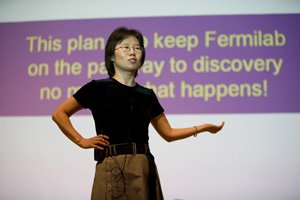| Wednesday, August 29, 2007 |
| Subscribe | Contact Fermilab Today | Archive | Classifieds |
Kim presents plan to Fermilab audience
The roadmap to Fermilab's future continues to point toward the proposed International Linear Collider, said Fermilab Deputy Director Young-Kee Kim at a labwide meeting on Friday. In case the construction of the ILC does not proceed on the proposed timeline, Fermilab proposes to pursue neutrino science and precision physics opportunities by upgrading the laboratory's proton accelerator complex. If the ILC experiences significant delay, Fermilab would use ILC technology to create a research program based on Project X, providing the laboratory with frontier physics opportunities while advancing the ILC. Project X would replace the 35-year-old injection complex at Fermilab, providing an intense source of protons to sustain a program of discovery in neutrino science and precision physics. The two-tiered plan of working toward Project X and the International Linear Collider will tax current resources at Fermilab and in the U.S. particle physics community, but eventually pay off for American particle physics, said Kim, presenting the recommendations by the Fermilab Steering Group. More than 500 lab employees and users attended the presentation in Ramsey Auditorium. Kim repeatedly stressed that the ILC is Fermilab's highest priority and that the laboratory's current 160-person commitment for ILC research and development will not decrease. In fact, building Project X, essentially a mini-ILC with about one percent of its energy, will further the goal of the ILC, Kim said. Because the design of Project is so similar to that of ILC's main linac, many of the approximately 30 people needed to design and plan Project X and to develop linac components of Project X also will contribute to ILC technology. Project X will support industrialization of superconducting radio-frequency cavities and cryomodules, as well as create a system test for many ILC components. Eventually, if and when the ILC is built, Project X could feed a damping ring in the Tevatron tunnel to debug some key components of the ILC before installation at depth, advancing the physics time scale for the ILC. "This is not Plan B. This is a single integrated plan that maintains the focus of catching the ILC, but also sustains Fermilab," said Fermilab Director Pier Oddone. Construction of Project X would only occur if the ILC strays significantly from its plan to break ground in 2012. The need for international funding agreements, selection of a host site and physics results from the Large Hadron Collider at CERN could open a gap long enough to require Project X. Fermilab and the United States need a plan for top-notch research facilities if that occurs. Fermilab's Tevatron will shut down by 2010, as will accelerator-based physics projects at other U.S. labs. For an ongoing program of discovery in U.S. particle physics, it is necessary for our country to continue to provide world-class facilities and be prepared with an interim research project, Kim said. Questions at Friday's meeting centered on how the R&D process would work without harming the ILC R&D effort. Scientists also expressed concern that Project X might sap resources for the proposed SNuMI project, an upgrade of NuMI that would occur in place of Project X in the event of a short delay in ILC construction. Oddone said R&D for Project X initially would eat up resources that could otherwise be devoted to SNuMI, but that making the investment now in Project X is a compelling choice in view of the available resources. If Fermilab should decide to build SNuMI later, it is a smaller and shorter project than Project X, Oddone said. "Resources could be available at a higher level in future years," Oddone said, "as three particle physics facilities shut down: CESR at Cornell, the B-factory at SLAC and the Tevatron at Fermilab." During the next six months, Fermilab will make the case for the plan to advisory panels of the U.S. Department of Energy's Office of High Energy Physics. "The key is to communicate the excitement of the physics," Oddone said. Already, the project has received support from Fermilab's Accelerator Advisory Committee, which has members from across the globe, and from many of the most passionate proponents of the ILC, Kim said. Nevertheless, Kim added, Fermilab must be sensitive to fears that Project X will sap the United States' interest in the ILC--or that with Project X the U.S. is trying to stack the deck to win the right to host the ILC. "Our plan here is to keep Fermilab on the pathway to discovery no matter what happens," she said. A second presentation of the Steering Group Report is scheduled for 5 p.m. Sept. 27 in One West. --Tona Kunz More information on the Steering Group is available here. |
